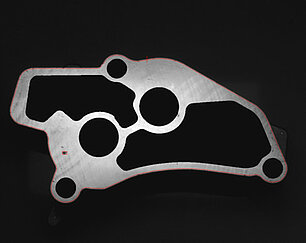
Solutions according to inspection characteristics
Over the years, visicontrol has developed into a specialist for dimensional and surface inspection. Surface inspection is considered the supreme discipline of industrial image processing.
visicontrol offers inspection and sorting machines as well as in-line inspection systems from a single source. Our goal is to install a turnkey autonomous inspection system at our customers' premises. We have been doing this so successfully for 30 years that 80% of our customers have implemented two or more systems with us.
The core product of visicontrol is the highly acclaimed and innovative inspection software visiTeach+.
To give an overview of already realized or projected inspection solutions we have compiled an excerpt:
Shell surface inspection (360° inspection)
As soon as surface defects on rotationally symmetrical components are to be reliably detected, our Sequencer module is used. By means of multiple image sequences from matrix cameras combined with a turning station, up to 180 images per second are taken and evaluated. The unwound surface can thus be analyzed by visiTeach+ and the defects clearly identified.
Blowhole inspection
For the detection of blowholes, e.g. in aluminum die castings, especially on mechanically machined sealing surfaces. The size, accumulation and number of blowholes can be reliably detected and documented.
CFRP tape inspection (CFRP starting material)
The tape inspection is used for the starting material carbon fiber reinforced plastic. It is used to detect:
Manufacturing defects, material defects, resin pockets, fiber tufts, low resin content, joints, inhomogeneity.
Fabric inspection
Fabric inspection is used in the fiber composite industry and for technical fabrics. It is used to detect:
Broken threads, inhomogeneity, damage, fiber angle distortion, resin pockets, fiber tufts, low resin content, joints.
Surface inspection
Surface inspection is used on injection molded and metal test specimens such as turned parts. For this we use our latest technology to detect: Chatter marks, scratches and inhomogeneity of surfaces as well as edge sealing, paint and primer application or contamination.
Crack and shrinkage inspection
This is used to detect flaws in e.g. safety-relevant, metallic components.
Presence check
A field of application of the presence control is e.g. the inspection of the printed circuit board assembly in the electrical industry.
Orientation control
Orientation control can be used, for example, in the printing industry to check the orientation of the printed image.
Component identification
This is used for the clear identification of installed elements in order to avoid complaints.
Soldering control
A soldering inspection is used for automated quality assurance of soldered elements in the electrical industry.
Connector inspection
In modern vehicles, more and more cables and electronic components are being installed, which means that the number of plug connections is also increasing. The connector inspection is used for under- and overmolding control, for checking the pin tip position and the flawlessness of metal inserts such as solder pads.
Pin inspection
Pin inspection is a special inspection for connectors to ensure that the pins and mating parts fit perfectly.
Thread inspection
Today's requirements for the supply industry are moving towards 0-ppm defective parts. To ensure this, thread inspection is not only used to check safety-relevant screw connections, but also to differentiate between thread type and quality. This ensures that only 100% tested threads leave your plant.
Blank inspection
During board inspection, boards can be monitored as a component in the production process and defective components can be rejected at an early stage. The board is checked for completeness, assembly and alignment.
Print image control
There are many regulations which information has to be applied to a component, e.g. by printing. The print image control checks whether the print image is correct and legibility is ensured.
Bin picking
Dimensional inspection for high-precision checking of component geometry
Fiber angle inspection also for technical fabrics and scrims: detection and measurement of fiber angles and distortions
Component inspection for the manufacturing industry from turned parts to sintered high-performance magnets
Roundness control for fits and other highest demands on roundness
Height control for precise measurement of component geometries with maximum throughput
Concentricity
Optical comma chip control
Optical ring chip control
Optical assembly control of components
And many more!